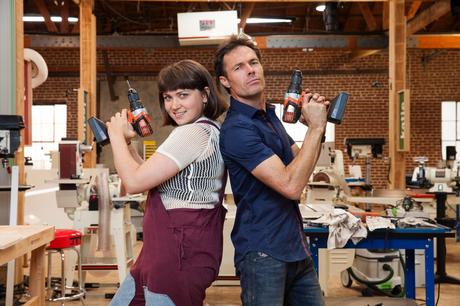
Brooklyn furniture designer Katie Stout took home the top prize of $100,000 when she won Ellen's Design Challenge with the help of her appointed carpenter, HGTV veteran Karl Champley.
Image courtesy of Ellen's Design Challenge.Take a look at any of the bold furniture pieces Katie Stout created on Ellen’s Design Challenge with the help of her partnered carpenter, Karl Champley, and it’s clear why the pair stuck around until the final episode of the HGTV design show. Aside from a slightly dramatic twist at the end of the competition, which began with a less-than-desirable finale for the creative duo, the Brooklyn-based Stout is quite deserving of her favorable win and the success that’s sure to follow.
A graduate of RISD, Katie Stout has already seen her work exhibited at Art Basel and in Milan. Plus, she’s graced the cover of New York Magazine’s Design Issue.
In preparation for Stout and Champley’s appearance at Dwell on Design Los Angeles next month, Dwell asked them to share a few previously untold details about their exciting journey on Ellen’s Design Challenge.
Dwell: What was your most memorable experience during the making of the show?
Katie Stout: I have to say the cow table (laughs).
Karl Champley: Good for you.
Stout: We did very well for the first two challenges, and then on the third I wanted to take a risk. I thought it was a great opportunity to experiment and to learn about a new material and a new method. Karl and I just said, "Let’s go with it!" Then he made this really funny udder platter to go on top of this table. This was one of those moments where it could have seemed like the end, but instead we just thought, No, this is great. It’ll be fine.
Champley: It’s true. That’s what’s so awesome about Katie; she has the strength and she’s bold enough to make these moves. The first night, we had half an hour to mix and pour the plaster into a mold I created. It was just kind of insane, and a mess, but it was fun. We didn’t care how messy we got. People were looking over, as if thinking, ‘What in the hell?’ It was just so much fun. We had plaster in places you cannot even write about.
Dwell: Throughout the season, your designs often stood out from the others. What inspires you to create the designs you make?
Stout: There are some materials that call to me, and others that don’t; for example, wood does not call to me. On the show, I used a lot of plastic. Until that point, I had never used plastic in my designs. It was appealing to use the CNC Router machine, which was also something new. I just felt this desire to explore and learn about new materials. Right now, in my designs, I use a lot of braided rugs to make furniture. I try to imagine what a certain material can be, and I go from there.
Dwell: Can you share an experience that wasn't on camera?
Champley: Whenever I build anything, like the sofa, I always use a template. That way, everyone working on the project can see in full scale what it’s going to look like. With the sofa, Katie came up with an awesome design, which I then transferred onto the template. We had it all ready for the upholsterers, but when we showed them the design, they said, "We can’t do that." They didn’t have the time and they didn’t have the manpower. But, it’s my job to get the designer to the next level, and if I can’t get my designer’s design made, then she’s out, we’re out. I said, "What can I do to help you get this done?" They told me the couch would have to be built in six different pieces. So I said, "Give me an hour, I’ll get it done."
On the second day we didn’t have a lot of work because the sofa was with the upholsterers, so Katie decided to design an acrylic base and two acrylic armrests to go with the templated design. We worked that entire day cutting up various different colors of acrylic.
When we got the sofa back, we put the sofa on the base that Katie and I built, and it was too high—someone who worked on the sofa decided it was too low, made a decision to increase the height, and they added a thicker cushion, not realizing we were going to add the base.
This is the sort of thing you don’t see on camera. As a builder, I’m basically a troubleshooter and we expect that sort of thing to happen, but I’ve got a designer on one side that’s almost in tears, and I almost was too, because after all of that work, the plan doesn’t work. And you just have to go with it. So we did.
